1867 Scott 11a 20pa blue green
Type 2
Into the Deep Blue
As discussed before in these blog posts..
...the 1867 lithographic issue presents some very interesting challenges for the collector: Namely the differences among the four engravings resulted in four major types on the stones, so that any block of four will have the four types. For a sheet of 200, there will be 50 of each type.
What makes it even more challenging is the information on the four types isn't easily found. Yes, the Egypt specialist literature has it, but all the major catalogs do not give specific information.
Well, I went on a quest to find the four types each of the six denominations. So far, I have four types for the 5pa orange (published link above), three types for the 10pa lilac, two types for the 1pi rose red, two types for the 2pi blue, and one type for the 5pi brown. Finding more type used copies of the 10pa, 1pi, and 2pi is still feasible (CV $10+), but, budget wise, probably not for the 5pi (CV $200). I will continue to try to obtain all four types for the 10pa, 1pi, & 2pi denominations. This is not just because I am a "completist": For my own stamps, I can scan @1200, and pick up all the subtle changes seen in types - the pics and scans available elsewhere are of lower resolution.
Now the good news: I also have all four types for the 20 Para greens! So here we go!
1869 Scott 11 20pa yellow green
Type 1
There were two printings of the 20pa (1867, 1869), and they differ somewhat by color. Smith, in his Egypt book, states the colors of the 1867 printing are pale to dark myrtle green, a scarce light green, and a pale apple green (color trial). The 1869 color is described as "bright green" - but often listed as "yellow-green", in comparison to the 1867 myrtle green "bluish" tinge.
Scott has the 1869 Scott 11 yellow-green as the major number, with the 1867 11a blue green as a minor number (CV used $14/ $17 respectively). SG has 1867 SG 13 deep blue green, 13a pale blue green, and 7/ 1869 SG 13b yellowish green. Michel has 1867 10a green, and 1869 10b yellow green.
1869 Scott 11 20pa yellow green
Ionic Column, Type 1
There are a number of signs for Type I, and the left panel "Ionic Column" area presents one of the best. There are more signs for Type 1, which we will present further along. I should mention that all the signs presented (until I state otherwise) are part of the "Official" list found in the appendix after chapter XIII - The Second Issue in Smith's book. (More information about Smith's book in the 5 PARA blog post.)
1867 Scott 11a 20pa blue green
Type 2
Type 2 was the last type I acquired, and I had to obtain my example from the Netherlands. !! Much of early Egyptian issue stamps seem to reside in Europe. Also, if one is hunting for 1867-69 issue "Types", be aware that most dealers/sellers do not identify the type. That will be your job!
I spotted Type 2 by the sign "numerals 2 are narrow and tilt to the left" (very useful sign!).
Type 2 Center Oval close-up
For Type 2, the summit of the pyramid is clear of the frame line, unlike the other types. This is actually a bit of a subtle sign, and requires an explanation. For Type 2, the summit (tip) of the pyramid clears (is above) the top horizontal frame line within the oval, but does not touch (in any form) the thin oval frame line above. The other types have the tip either stop (just touch) the horizontal frame line (Type 1,4), or actually touch the thin oval frame line (Type 3). (Note: Also Type 4 actually has a line that extends from the tip to the oval frame line.)
Type 1,2,3,4 top to bottom
Pyramid Tip
Here is a close-up of the pyramid tips for the four types. As said, Type 2 is the only one with a tip that is clearly above the top horizontal line, and also clearly ends before the thin oval frame above it. Although it is listed as one of the "official" signs, it is subtle enough that it should probably be used as a confirmatory sign rather than a diagnostic sign.
1867 Scott 11a 20pa blue green
Type 3
Here is Type 3. We will show Type 3's signs further down.
I should mention that I have a lot more 20pa stamp examples than I am illustrating on this blog (Don't want to clutter!). For Type 1, three stamps, for Type 2, only one stamp!, for Type 3, two stamps, and for Type 4, five stamps! Type 4 stamps are quite interesting, and require more examples to illustrate, as we shall see next.
1869 Scott 11 20pa yellow green
Type 4
It turns out that only one stone was used for printing the 5pa, 10pa, 2pi & 5pi. But, "Two or more stones , differing in orthographic detail of the Arabic inscription on the bottom were required for the 20pa and 1pi". It further turns out that there is a fairly easy sign to spot on the Type 4 stamps that determines Stone A from Stone B.
In order to look at stone A/stone B differences, we first need to know if this is a Type 4 stamp. Although there are other signs for Type 4 that we will discuss further on, the most diagnostic sign is a "tear-drop hanging from the ball of the "2" on the right side. Do you see it here - the white dot below the ball of "2"? This is a Type 4 stamp.
Then look at the far left Arabic word - there are two dots above the script and to the left of the right end of the script (- that also ends in an attached ball dot.) This is Stone A.
Here is another example close-up of the diagnostic Type 4 white dot below the ball of the "2" on the right side. Sometimes the dot is very prominent, sometimes less so, but should always be there for a Type 4 stamp.
OK, let's look at the far right Arabic word in the bottom panel. The word fadda (para) at the left end of the bottom inscription should only have two dots. The original Stone though, was made with three dots. The thought is, when the transfer was made to the printing Stone A , the unwanted dot was stopped out or de-inked. Hence Stone A shows the proper word with only two dots, as above.
20pa yellow green, Example 2
Type 4
Ok, this is a Type 4, as evidenced by the white dot below the ball of the right "2".
But the far left Arabic word has three dots! This is Stone B. What happened? When Stone B was made, the printers overlooked the unwanted dot, which therefore appeared in full on the original stone and the printing stone. !!
20pa blue green, Example 3
Type 4
Another example of Type 4. The dot is less prominent below the ball of the right "2", but definitely there.
And, this example also shows three dots for the far left fadda Arabic word: Therefore Stone B!
Type 1,2,3,4 top to bottom
Bottom Panel
Now we are getting into some of the heart of the differences between types.
For Type 1, the second dot from the left touches the frame line above it. You will note that it does not occur for any other type. Diagnostic.
For Type 2, the numerals 2 are narrow and tilt to the left. Diagnostic.
For Type 2, the three dots above the right hand word are farther to the left than in the other types. Diagnostic.
For Type 4, in the upper left of the 2 in the right hand corner is a small colorless dot. Described as a "teardrop hanging from the ball of the 2". Diagnostic.
Type 1,2,3,4
Top Panel
For Type 2, in the right side PARA, the P and A are spaced apart. Diagnostic.
For Type 3, the second A of the right side word PARA is narrow and close against the right. But Type 2 & 4 also have narrow A's in this position: Just not quite as narrow.
For Type 3, the second dot from the left is closer to the stroke below it than on the other types. Diagnostic.
For Type 4, in the left word PARA, the sloping leg of the R is thick and broken. Diagnostic.
For Type 4, the letter ya' (looks like a large florid S) does not touch the frame line below, unlike the other types. Diagnostic.
OK, the signs discussed above were all part of the "official" signs listed in Smith's book and in the Egyptian philatelic literature. They are probably sufficient for most collectors. But there are additional "markers" if one examines other parts of the stamp that can provide confirmatory signs. So, dear reader, if your eyes have not glazed over yet, here are some more markers below. ;-)
Upper Column Close-up
Type 1,2,3,4 Top to bottom
Look at the left side of the stamp, and examine the upper Column and Capital area. One will note that the stroke markings within the Capital are unique for each type. Some of my stamps show the marking better than others due to worn plates. Here, Type 2's markings are light, but still there with careful inspection.
Upper Obelisk Close-up
Type 1,2,3,4 Top to Bottom
One will notice that the markings on the upper Obelisk, although similar for all types, have enough subtle stroke differences to identify each type. Helps to scan @1200! ;-)
Sphynx Face Close-up
Type 1,2,3,4 Top to Bottom
There are enough differences in stroke markings on the face to help confirm a type. I will let the reader pick out their favorite differences.
Center Oval Close-up
Type 1,2,3,4 Top to Bottom
Check the dark thick oval and it's position. Does it touch the rectangular frame on any side? Here, for type 1, type 2,and type 4 it clears on all sides (sometimes barely). Type 3 touches the right frame line.
You can count the horizontal lines on each side of the pyramid. Actually, in the case of the 20 Para, I get 20 lines on the left and right side for all types.
Check the position of the sphinx head within the pyramid. Type 4 head is very close to the left edge of the pyramid.
Check the width of the drawing of the right side face of the pyramid. Type 2 looks wider.
The reader can probably find other subtle markers and stroke differences with inspection.
Out of the Blue
Will there be additional posts showing the type differences for the other 1867 issue denominations (10pa, 1pi, 2pi, 5pi)? Maybe. I need more material.
In the meantime, Ron of Classic Stamp Forgeries has recently published a review of the Egypt 1867 issue. He lists salient characteristics for all four types of each denomination of the 1867 issue. Although his images do not show as much detail (mainly because I am scanning the stamps in my collection at a very high resolution (1200)), it is a very welcome addition indeed.
Comments appreciated!




















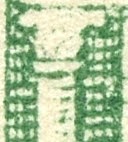


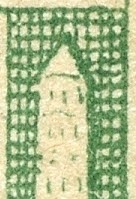
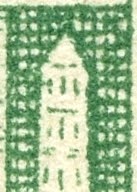

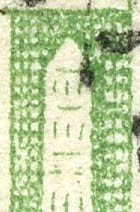





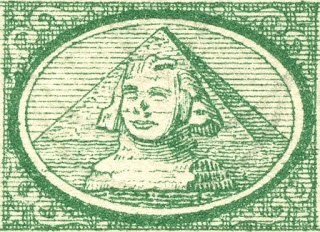


No comments:
Post a Comment